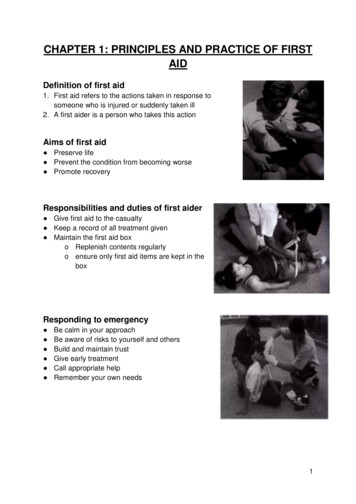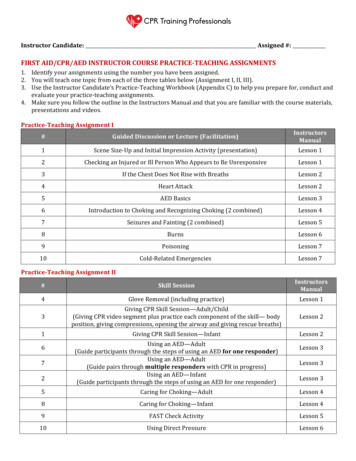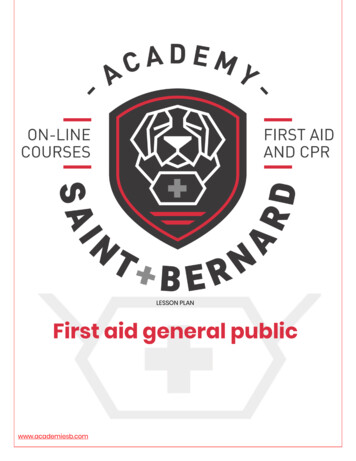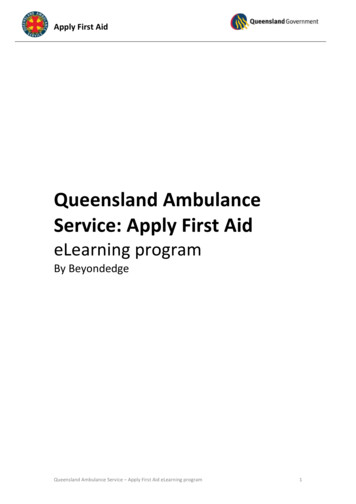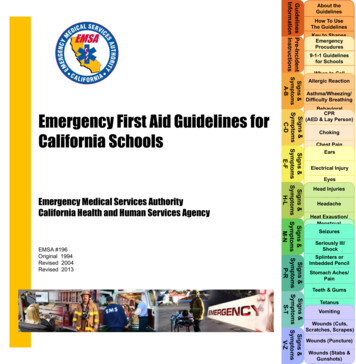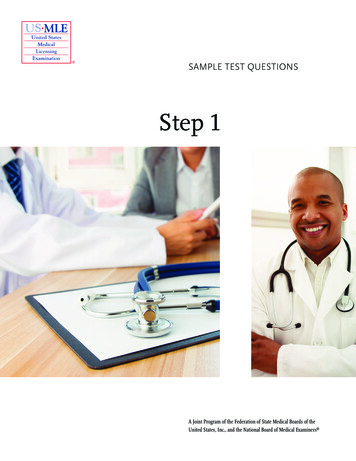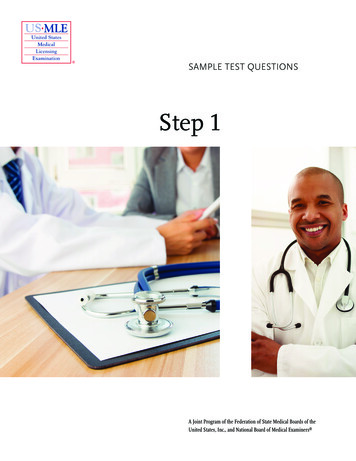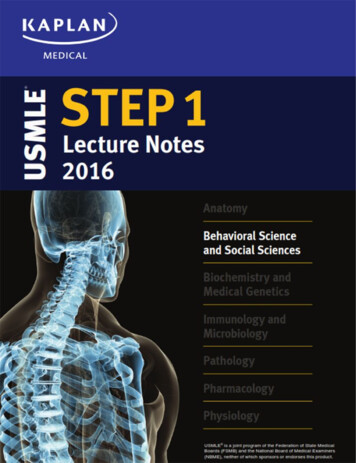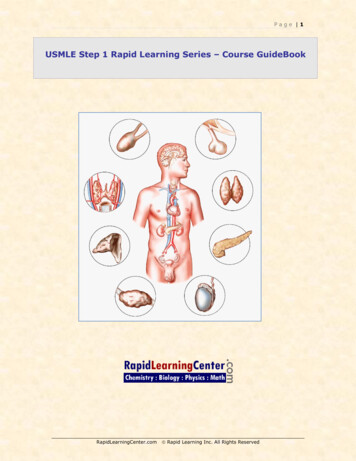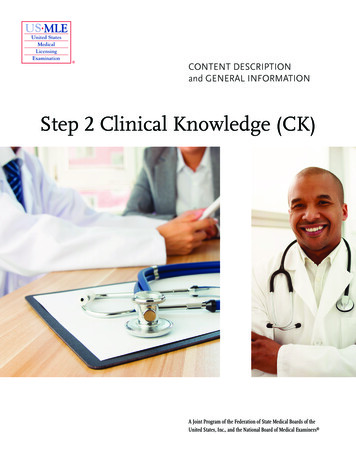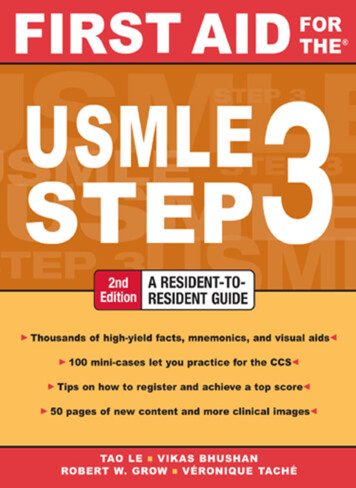
Transcription
FIRST AIDUSMLESTEP 3Second EditionTAO LE, MD, MHSAssistant Clinical ProfessorChief, Section of Allergy and Clinical ImmunologyDepartment of MedicineUniversity of LouisvilleVIKAS BHUSHAN, MDDiagnostic RadiologistROBERT W. GROW, MD, MSResident PhysicianDepartment of Emergency MedicineMayo ClinicVÉRONIQUE TACHÉ, MDFellow, Maternal-Fetal MedicineDepartment of Reproductive MedicineUniversity of California, San DiegoNew York / Chicago / San Francisco / Lisbon / London / Madrid / Mexico CityMilan / New Delhi / San Juan / Seoul / Singapore / Sydney / TorontoFORTHE
Copyright 2008 by Tao T. Le. All rights reserved. Manufactured in the United States of America. Except as permitted under the United States Copyright Act of 1976, nopart of this publication may be reproduced or distributed in any form or by any means, or stored in a database or retrieval system, without the prior written permission of thepublisher.0-07-159458-2The material in this eBook also appears in the print version of this title: 0-07-148796-4.All trademarks are trademarks of their respective owners. Rather than put a trademark symbol after every occurrence of a trademarked name, we use names in an editorial fashion only, and to the benefit of the trademark owner, with no intention of infringement of the trademark. Where such designations appear in this book, they have been printedwith initial caps.McGraw-Hill eBooks are available at special quantity discounts to use as premiums and sales promotions, or for use in corporate training programs. For more information,please contact George Hoare, Special Sales, at george hoare@mcgraw-hill.com or (212) 904-4069.TERMS OF USEThis is a copyrighted work and The McGraw-Hill Companies, Inc. (“McGraw-Hill”) and its licensors reserve all rights in and to the work. Use of this work is subject to theseterms. Except as permitted under the Copyright Act of 1976 and the right to store and retrieve one copy of the work, you may not decompile, disassemble, reverse engineer,reproduce, modify, create derivative works based upon, transmit, distribute, disseminate, sell, publish or sublicense the work or any part of it without McGraw-Hill’s prior consent. You may use the work for your own noncommercial and personal use; any other use of the work is strictly prohibited. Your right to use the work may be terminated ifyou fail to comply with these terms.THE WORK IS PROVIDED “AS IS.” McGRAW-HILL AND ITS LICENSORS MAKE NO GUARANTEES OR WARRANTIES AS TO THE ACCURACY,ADEQUACY OR COMPLETENESS OF OR RESULTS TO BE OBTAINED FROM USING THE WORK, INCLUDING ANY INFORMATION THAT CAN BEACCESSED THROUGH THE WORK VIA HYPERLINK OR OTHERWISE, AND EXPRESSLY DISCLAIM ANY WARRANTY, EXPRESS OR IMPLIED, INCLUDING BUT NOT LIMITED TO IMPLIED WARRANTIES OF MERCHANTABILITY OR FITNESS FOR A PARTICULAR PURPOSE. McGraw-Hill and its licensors donot warrant or guarantee that the functions contained in the work will meet your requirements or that its operation will be uninterrupted or error free. Neither McGraw-Hill norits licensors shall be liable to you or anyone else for any inaccuracy, error or omission, regardless of cause, in the work or for any damages resulting therefrom. McGraw-Hillhas no responsibility for the content of any information accessed through the work. Under no circumstances shall McGraw-Hill and/or its licensors be liable for any indirect,incidental, special, punitive, consequential or similar damages that result from the use of or inability to use the work, even if any of them has been advised of the possibility ofsuch damages. This limitation of liability shall apply to any claim or cause whatsoever whether such claim or cause arises in contract, tort or otherwise.DOI: 10.1036/0071487964
ProfessionalWant to learn more?We hope you enjoy thisMcGraw-Hill eBook! Ifyou’d like more information about this book,its author, or related books and websites,please click here.
D E D I C AT I O NTo the contributors to this and future editions, who took time to share theirexperience, advice, and humor for the benefit of students.andTo our families, friends, and loved ones, who endured and assisted in thetask of assembling this guide.Copyright 2008 by Tao T. Le. Click here for terms of use.
This page intentionally left blank
For more information about this title, click hereCONTENTSAuthorsviiFaculty ReviewersixPrefacexiAcknowledgmentsxiiiHow to ContributexvS EC T I O N IG U I D E TO T H E U S M LE ST E P 31S EC T I O N I S U P P L E M E N TG U I D E TO T H E CC S9S EC T I O N I IDATABA S E O F H I G H-Y I E LD FAC TS15Ambulatory Medicine17Cardiovascular31Emergency Medicine45Endocrinology63Ethics and y123Infectious ry271Pulmonary291v
S EC T I O N I I IH I G H-Y I E LD CC S C A S E S305Appendix393Index399About the Authors415vi
AUTHORSAditya Bardia, MBBS, MPHGautam Kumar MBBS, MRCP(UK)Resident PhysicianDepartment of Internal MedicineMayo ClinicFellowDivision of Cardiovascular DiseasesDepartment of MedicineMayo ClinicJonas Green, MD, MPHResident PhysicianDepartment of General Internal MedicineUniversity of California, Los AngelesChristopher Moreland, MDResident PhysicianDepartment of Internal MedicineUniversity of California, Davis Medical CenterAline Hansen-Guzmán, MDJason H. Szostek, MDResident PhysicianDepartment of Family and Community Medicine andDepartment of Obstetrics and GynecologyUniversity of California Davis Health SystemResident PhysicianDepartment of Internal MedicineMayo ClinicMartha Karakelides, MDResident PhysicianDepartment of Internal MedicineMayo ClinicEsther H. Krych, MDResident PhysicianDepartment of Pediatric and Adolescent MedicineMayo ClinicJulie Suzumi Young, MD, MSResident, PsychiatryDepartment of Psychiatry and Behavioral HealthUniversity of California, DavisAmy Mikail Wolf, MD, MPHResident PhysicianDepartment of Internal MedicineUniversity of California, DavisviiCopyright 2008 by Tao T. Le. Click here for terms of use.
This page intentionally left blank
FACULTY REVIEWERSJeremy Cooke, MDNicholas Stollenwerk, MDAssistant ProfessorDepartment of Emergency MedicineThe University of California, Davis Medical CenterClinical FellowDivision of Pulmonary and Critical CareUniversity of California, Davis Medical CenterStephen Crane Hauser, MDDavid Taylor, MDAssistant Professor of MedicineConsultant, Division of Gastroenterology and HepatologyMayo ClinicAssociate Physician DiplomateDivision of NephrologyDepartment of General Internal MedicineUniversity of California, Los AngelesHelen KarakelidesSenior Associate ConsultantDivision of Endocrinology, Diabetes, Metabolism and NutritionMayo ClinicKyle W. Klarich, MDConsultantCardiovascular DiseasesMayo ClinicRobert M. McCarron, DOProgram DirectorInternal Medicine / Psychiatry ResidencyDepartment of Psychiatry and Behavioral SciencesDepartment of Internal MedicineUniversity of California, DavisLauren McGovern, MDProfessorDepartment of Pediatric and Adolescent MedicineMayo ClinicJason Napolitano, MDClinical InstructorDepartment of General Internal MedicineUniversity of California, Los AngelesPritish K. Tosh, MDFellowDivision of Infection DiseasesMayo ClinicShaji K. Kumar, MDAssociate Professor of MedicineDivision of HematologyMayo ClinicLiza H. Kunz, MDDivision of Maternal Fetal MedicineSanta Clara Valley Medical CenterSan Jose, CaliforniaL. Elaine Waetjen, MDAssociate ProfessorDepartment of Obstetrics and GynecologyUC Davis Medical CenterChristopher M. Wittich, PharmD, MDChief ResidentDepartment of MedicineMayo ClinicRavi D. Rao, MBBSAssistant ProfessorDepartment of OncologyMayo ClinicixCopyright 2008 by Tao T. Le. Click here for terms of use.
This page intentionally left blank
PREFACEWith First Aid for the USMLE Step 3, we continue our commitment toproviding residents and international medical graduates with the mostuseful and up-to-date preparation guides for the USMLE exams. Thissecond edition represents a thorough review in many ways and includesthe following: An exam preparation guide for the computerized USMLE Step 3with test-taking strategies for the FRED format.A high-yield guide to the CCS that includes invaluable tips andshortcuts.A review of hundreds of high-yield Step 3 topics with an emphasison management.One hundred minicases with presentations and management similarto CCS cases.We invite you to share your thoughts and ideas to help us improve FirstAid for the USMLE Step 3. See How to Contribute, p. xv.LouisvilleLos AngelesRochesterSacramentoTao LeVikas BhushanRobert W. GrowVéronique TachéxiCopyright 2008 by Tao T. Le. Click here for terms of use.
This page intentionally left blank
ACKNOWLEDGMENTSThis has been a collaborative project from the start. We gratefully acknowledge the thoughtful comments, corrections, and advice of the residents, international medical graduates, and faculty who have supportedthe authors in the development of First Aid for the USMLE Step 3.Thanks to William Shakespeare; Matthew Thompson; Ravi Gada; LindaDao; Jeremy Cooke, MD and Mark Mansour, MD for their support tothe authors during the manuscript preparation process.For support and encouragement throughout the process, we are grateful to Thao Pham, Selina Bush, and Louise Petersen.Thanks to our publisher, McGraw-Hill, for the valuable assistance oftheir staff. For enthusiasm, support, and commitment to this challenging project, thanks to our editor, Catherine Johnson. For outstandingeditorial work, we thank Andrea Fellows. A special thanks to DavidHommel (Rainbow Graphics) for remarkable production work.LouisvilleLos AngelesRochesterSacramentoTao LeVikas BhushanRobert W. GrowVéronique TachéxiiiCopyright 2008 by Tao T. Le. Click here for terms of use.
This page intentionally left blank
HOW TO CONTRIBUTETo continue to produce a high-yield review source for the USMLE Step 3 exam, you are invited to submit any suggestions or corrections. We also offer paid internships in medical education and publishingranging from three months to one year (see next page for details).Please send us your suggestions for Study and test-taking strategies for the computerized USMLE Step 3.New facts, mnemonics, diagrams, and illustrations.CCS-style cases.Low-yield topics to remove.For each entry incorporated into the next edition, you will receive a 10 gift certificate, as well as personal acknowledgment in the next edition. Diagrams, tables, partial entries, updates, corrections, andstudy hints are also appreciated, and significant contributions will be compensated at the discretion ofthe authors. Also let us know about material in this edition that you feel is low yield and should bedeleted.The preferred way to submit entries, suggestions, or corrections is via the First Aid Team’s blog atwww.firstaidteam.com. Please include name, address, school affiliation, phone number, and e-mailaddress (if different from the address of origin).N OT E TO CO N T R I B U TO R SAll entries become property of the authors and are subject to editing and reviewing. Please verify all dataand spellings carefully. In the event that similar or duplicate entries are received, only the first entry received will be used. Include a reference to a standard textbook to facilitate verification of the fact. Pleasefollow the style, punctuation, and format of this edition if possible.I N T E R N S H I P O P PO RT U N I T I E SThe author team is pleased to offer part-time and full-time paid internships in medical education and publishing to motivated physicians. Internships may range from three months (e.g., asummer) up to a full year. Participants will have an opportunity to author, edit, and earn academic credit on a wide variety of projects, including the popular First Aid series. Writing/editingexperience, familiarity with Microsoft Word, and Internet access are desired. For more information, e-mail a résumé or a short description of your experience along with a cover letter to theauthors at www.firstaidteam.com.xvCopyright 2008 by Tao T. Le. Click here for terms of use.
This page intentionally left blank
SECTION IGuide to the USMLEStep 3 Introduction USMLE Step 3—Computer-BasedTesting Basics USMLE/NBMEResources Testing Agencies1Copyright 2008 by Tao T. Le. Click here for terms of use.
G U I DE TO TH E USM LE STE P 3INTRODUCTIONFor house officers, the USMLE Step 3 constitutes the last step one must taketoward becoming a licensed physician. For international medical graduates(IMGs) applying for residency training in the United States, it represents anopportunity to strengthen the residency application and to obtain an H1Bvisa. Regardless of who you are, however, do not make the mistake of assuming that the Step 3 exam is just like Step 2. Whereas Step 2 focuses on clinicaldiagnosis, disease pathogenesis, and basic management, Step 3 emphasizesinitial and long-term management of common clinical problems in outpatient settings. Indeed, part of the exam includes computerized patient simulations in addition to the traditional multiple-choice questions.Step 3 is not a retread ofStep 2.In this section, we will provide an overview of the Step 3 exam and will offeryou proven approaches toward conquering the exam. For a high-yield guide tothe Computer-Based Clinical Simulations (CCS), go to Section I Supplement: Guide to the CCS. For a detailed description of Step 3, visitwww.usmle.org or refer to the USMLE Step 3 Content Description and Sample Test Materials booklet that you will receive upon registering for the exam.U S M LE ST E P 3—CO M P U T E R-BA S E D T E ST I N G BA S I C SHow Is Step 3 Structured?The Step 3 exam is a two-day computer-based test (CBT) administered byPrometric, Inc. The USMLE is now using new testing software called FRED.FRED allows you to highlight and strike out test choices as well as makebrief notes t
Study and test-taking strategies for the computerized USMLE Step 3. New facts, mnemonics, diagrams, and illustrations. CCS-style cases. Low-yield topics to remove. For each entry incorporated into the next edition, you will receive a 10 gift certificate, as well as per-sonal acknowledgment in the next edition. Diagrams, tables, partial entries, updates, corrections, and

